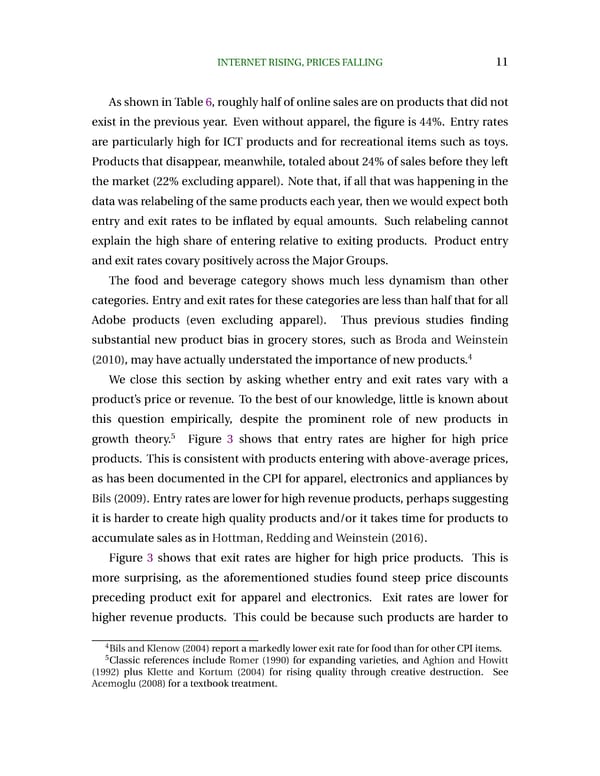INTERNETRISING,PRICESFALLING 11 AsshowninTable6,roughlyhalfofonlinesalesareonproductsthatdidnot exist in the previous year. Even without apparel, the figure is 44%. Entry rates are particularly high for ICT products and for recreational items such as toys. Productsthatdisappear,meanwhile,totaledabout24%ofsalesbeforetheyleft the market (22% excluding apparel). Note that, if all that was happening in the datawasrelabelingofthesameproductseachyear,thenwewouldexpectboth entry and exit rates to be inflated by equal amounts. Such relabeling cannot explain the high share of entering relative to exiting products. Product entry andexitratescovarypositivelyacrosstheMajorGroups. The food and beverage category shows much less dynamism than other categories. Entry andexitratesforthesecategoriesarelessthanhalfthatforall Adobe products (even excluding apparel). Thus previous studies finding substantial new product bias in grocery stores, such as Broda and Weinstein 4 (2010), mayhaveactuallyunderstatedtheimportanceofnewproducts. We close this section by asking whether entry and exit rates vary with a product’s price or revenue. To the best of our knowledge, little is known about this question empirically, despite the prominent role of new products in 5 growth theory. Figure 3 shows that entry rates are higher for high price products. This is consistent with products entering with above-average prices, as has been documented in the CPI for apparel, electronics and appliances by Bils (2009). Entry rates are lower for high revenue products, perhaps suggesting it is harder to create high quality products and/or it takes time for products to accumulatesalesasinHottman,ReddingandWeinstein(2016). Figure 3 shows that exit rates are higher for high price products. This is more surprising, as the aforementioned studies found steep price discounts preceding product exit for apparel and electronics. Exit rates are lower for higher revenue products. This could be because such products are harder to 4Bils and Klenow(2004)reportamarkedlylowerexitrateforfoodthanforotherCPIitems. 5Classic references include Romer (1990) for expanding varieties, and Aghion and Howitt (1992) plus Klette and Kortum (2004) for rising quality through creative destruction. See Acemoglu(2008)foratextbooktreatment.
 Internet Rising, Prices Falling Page 10 Page 12
Internet Rising, Prices Falling Page 10 Page 12